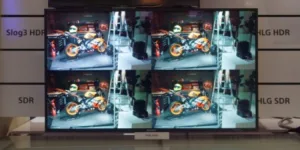The Sony press event started with a full volume corporate video. Interestingly for a projector maker, Sony used flat panel displays for its presentation, with the main one a large Bravia set.
Adam Fry, VP of Sony Professional, started by talking about Sony’s 70 years of history and its history of innovation. He said there are two critical needs in the video world, the first is to create compelling content and the second is to get that content to the devices that consumers want to use to access that content.
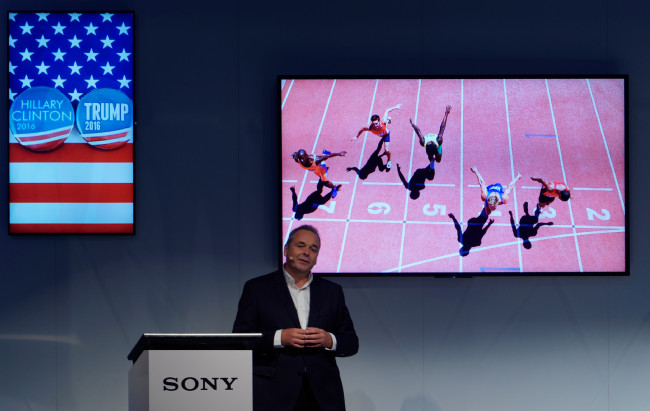 Sony’s Adam Fry forecast that 50% of Sony Professional’s revenue would come from services in the future. Image:Meko
Sony’s Adam Fry forecast that 50% of Sony Professional’s revenue would come from services in the future. Image:Meko
Fry believes that the Sony Professional group will become a 50% services business, rather than a device sales business. In sports, the services business is increasing and Sony currently covers 7,000 sports events annually and has developed the Premier League app and others (it already has three million downloads).
There are three drivers, image, IP and workflow.
Image
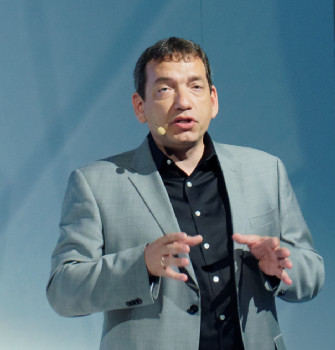 Michael Harrit, Marketing Director of Media Solutions, talked briefly about the Cledis display that was previously shown at Infocomm and was front and centre on the booth at IBC.
Michael Harrit, Marketing Director of Media Solutions, talked briefly about the Cledis display that was previously shown at Infocomm and was front and centre on the booth at IBC.
He then went on to say that there’s a new PVM-X550 quad OLED monitor that can show multiple HDR images (more later) and he said that there are new cameras in the hand held UltraHD class (FS5 & FS7) and in the CineAlta camera range and the Sony F65 was used in the Woody Allen “Cafe Society” movie, which opened the Cannes film festival. It was also used for Billy Lynn’s Long Half Time Walk, by Ang Lee. (see XXX)
The HDC-4300 has become the de-facto UltraHD system camera for sports. There is also a new UltraHD high frame rate (8x) camera with the HDC-4800 (or 16X in FullHD)
The camera “becomes a part of a network” and can store four hours of 8X UltraHD video in its own storage to make slow motion much more easily accessible. There are new servers and editor workstations from Sony that work across 10Gbps ethernet to allow faster live processing. Harrit said that there are a lot of UltraHD soccer matches being captured, now, and eight of the matches at the Euros were recorded in UHD and thirteen companies took live feeds in that resolution. 124 matches in the English Premier League were captured in UltraHD.
HDR and WCG are big issues for the industry and BT.2100 will be important in enabling the technology. Sony was showing a new scene-referred (SR) live workflow that allows the creation of SD, HD and UHD for SDR or HDR from a single stream, in real time. That’s a real game changer, Harrit said and Sony has developed the HDRC-4000 as a real-time converter for any of the HDR formats that are available. David Mazza, CTO of NBC Sports, was quoted as saying that NBC likes to use Sony’s own S-Log3 HDR curve, so that it can be converted to other formats and so that it can be archived for future use.
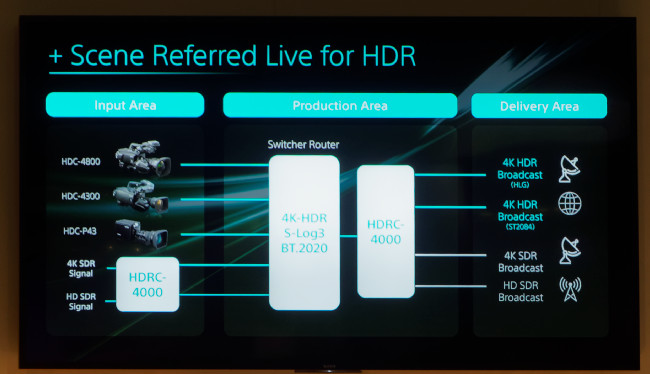 Sony’s SR Live Process Allows HDR & SDR Creation from a single capture. Image:Meko
Sony’s SR Live Process Allows HDR & SDR Creation from a single capture. Image:Meko
The HDC-P43 is a new 4K HDR and HFR ‘Point of View’ camera – can be used as a stand alone or can be used on a crane.
IP Delivery
Olivier Bovis, Head of Media Solutions, said that IP is a big issue for Sony and the company has an end to end live IP production system, based on open standards. There is a new Multiplexer and DeMultiplexer that can convert from SDI to IP (NXLK-IP45F). There is also an SDI-IP converter, the NXL-IP4F that can convert directly SDI from cameras (including UltraHD) to IP and a single network cable.
Sony has created a centre at Pinewood to train customers on, develop and introduce IP-based workflows.
Ronald Meyvisch CTO of Euro Media was introduced. Euro Media is a customer of Sony, is based in France and makes programmes in seven countries from acquisition to distribution. It has a framework agreement with Sony. The firm’s cameras all come from Sony and the company is working on remote production via IP with Sony. Euromedia said that the big thing from its point of view is that all facilities are available everywhere, although network bandwidth is still a big challenge. The Alliance for IP Media Solutions (AIMS Alliance) is a big help to get the industry working together, Meyvisch said and he is pleased that Sony became a member in April this year.
There is a need to get the IP guys to understand the image side and you need those passionate about the image to start to learn about network.
Workflow
The third driver is workflow, said Harrit, and there needs to be a balance between creativity and efficiency. Cloud technologies are changing everything. Sony is working on new workflows for news and there is a new Xdcam Air service for electronic news gathering (ENG). This allows the use of GPS and metadata automation to improve news production – it puts the internet at the front of the news.
Media Backbone Hive is a new omni media workflow engine built around the cloud. It can be offered as a product or as a service and Swisscom is already using the technology. Sony is developing a complete cloud-based remote production with Swisscom and that is claimed to be radically speeding up production and was used for the Locarno Film Festival. The trial used ENG and 4G with a cloud infrastucture that allows rapid production (reducing some processes from six hours to 10 minutes).
Media Backbone Navigator X is a new HTML 5 application that is a workflow engine. There are new optical storage systems coming for archiving and Sony is working with Indiana University on a major project to digitise 25,000 films in HD and UltraHD.
Booth Visit – New Broadcast Monitors Shown
We concentrated on the broadcast monitors at the show. There were a number of new units and we started looking a the new 17″ and 25″ BVM-E171 and BVM-E251 OLED monitors. These replace the existing models. The monitors are intended for grading and colour critical work and have 1920 x 1080 FullHD resolution. There is support for content in Rec 2020 format although the full gamut is not covered. There is a new processor engine that means that the monitor can support S-Log3 and S-Log2 content directly and the monitors have special features to allow the 1920 x 1080 to be used as a ‘window’ on 2048 x 1080 content where there is a need for pixel checking. Processing for colour management and gamma is in 12 bit and the company claims video latency of less than a single frame.
 A new Sony processor means new menus that are consistent across the range. Image:Meko
A new Sony processor means new menus that are consistent across the range. Image:Meko
The new monitors will replace two previous ranges, and although this will mean a 15% increase from the prices of the lower models, it is much less than the +100% price premium that was previously applied to the better version. They will be available in January 2017.
The new processor has a number of extra features, including the option of loading images from USB. That means that a TIFF image can be simply stored on a USB key one day and used for matching on another day, or to check lighting, for example.
There are also new LCD monitors with improved IPS panels that can reach 1,500:1 native contrast and with 10 bit driving. Again the new processor allows the extensive feature sets of the new models to be very common across a wide range of different models, with the same OSD and menu structure. The LMD-A240 has 1920 x 1200 resolution and has a much smaller case and lower weight than the previous model. MOnitor specialist, Daniel Dubreuil showed us the latest version of the focus assist that the monitors offer.
There is a new LMD-B170 which is a FullHD set using a 17.3″ diagonal TN panel. It is a significant upgrade on the previous 15″ model and again shares the processor and features of the higher models in the range, but with lower cost because of the panel. Other features include a waveform monitor and a vector scope. The depth is 24% less than the previous 15″ model and weight is the same. White balance can be remotely adjusted and checked.
The PVM-XC550 was shown at NAB and is lower down then scale than the BVM mastering series. The 55″ UltraHD OLED has a quadview mode built in and each of the four images can support a different EOTF, so that SDR and HDR content can be compared and contrasted. It supports “very close to” the full P3 gamut.
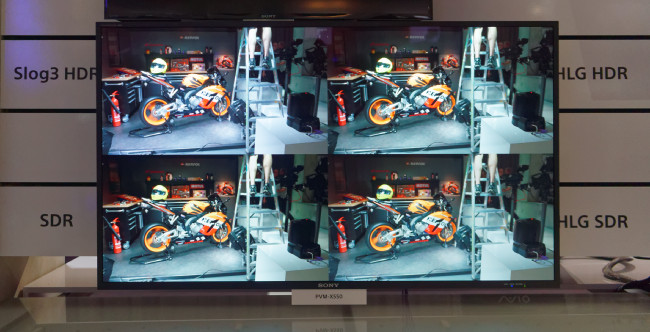 The Sony PVM X550 can use a different EOTF in each window. Image:Meko
The Sony PVM X550 can use a different EOTF in each window. Image:Meko
The BVM-X300 30″ OLED monitor is now in its second version has has an HDMI input and a second SDI input.
Sony has developed the BKM-17R, a remote control unit that can control up to 32 different monitors and uses the new menu structure and features. It also has a new casing system that allows 17″ monitors to be fitted with a cover glass for rental and ruggedised environments. Staff told us that another handy feature for rental is the ability to store a complete monitor set up as a default, allowing monitors to be easily reset after they have been with a client.
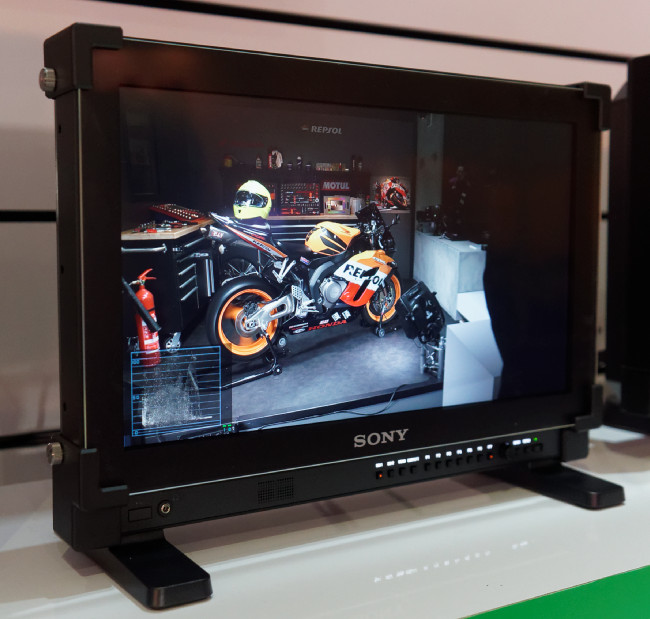 Sony Rental Protection Sony has a protection set that makes the unit suitable for rental. Image:Meko
Sony Rental Protection Sony has a protection set that makes the unit suitable for rental. Image:Meko
The Cledis display was on show and generally impressing everyone. The current version has a shiny surface and at IBC and Infocomm, Sony was careful to ensure that there were not too many reflections. While we were looking at the display, we noted a door at the RAI being opened and that showed as the reflection in the bottom left corner of the image below. We expect Sony to reduce the reflections by the time that the Cledis technology starts shipping in Q1 2017.
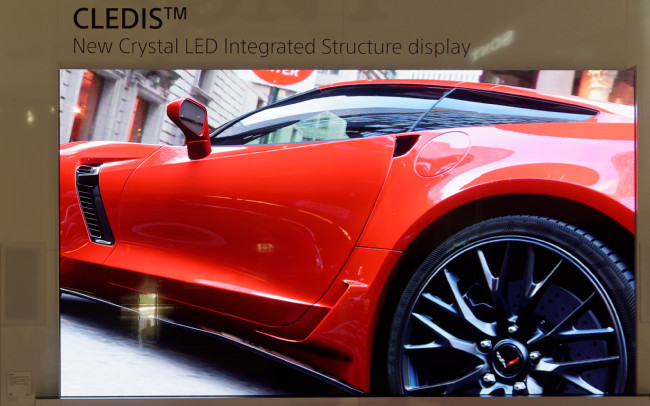 Note the reflections on the Sony Cledis, from an open door in the RAI. Image:Meko
Note the reflections on the Sony Cledis, from an open door in the RAI. Image:Meko

